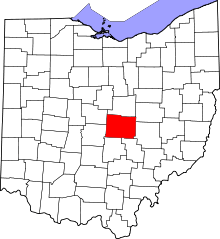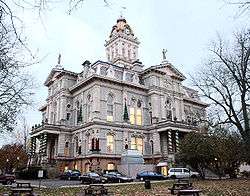Licking County, Ohio
| Licking County, Ohio | ||
|---|---|---|
|
Licking County Courthouse | ||
| ||
 Location in the U.S. state of Ohio | ||
 Ohio's location in the U.S. | ||
| Founded | March 1, 1808[1] | |
| Named for | Salt licks | |
| Seat | Newark | |
| Largest city | Newark | |
| Area | ||
| • Total | 687 sq mi (1,779 km2) | |
| • Land | 683 sq mi (1,769 km2) | |
| • Water | 5.0 sq mi (13 km2), 0.7% | |
| Population | ||
| • (2010) | 166,492 | |
| • Density | 244/sq mi (94/km²) | |
| Congressional district | 12th | |
| Time zone | Eastern: UTC-5/-4 | |
| Website |
www | |
Licking County is a county located in the U.S. state of Ohio. As of the 2010 census, the population was 166,492.[2] Its county seat is Newark.[3] The county was formed on January 30, 1808 from portions of Fairfield County. It is named for the salt licks that were in the area.[4]
Licking County is part of the Columbus, OH Metropolitan Statistical Area.
Geography
According to the U.S. Census Bureau, the county has a total area of 687 square miles (1,780 km2), of which 683 square miles (1,770 km2) is land and 5.0 square miles (13 km2) (0.7%) is water.[5] It is the third-largest county in Ohio by land area.
Adjacent counties
- Knox County (north)
- Coshocton County (northeast)
- Muskingum County (east)
- Perry County (southeast)
- Fairfield County (southwest)
- Franklin County (west)
- Delaware County (northwest)
Major highways
Demographics
| Historical population | |||
|---|---|---|---|
| Census | Pop. | %± | |
| 1810 | 3,852 | — | |
| 1820 | 11,861 | 207.9% | |
| 1830 | 20,869 | 75.9% | |
| 1840 | 35,096 | 68.2% | |
| 1850 | 38,846 | 10.7% | |
| 1860 | 37,011 | −4.7% | |
| 1870 | 35,756 | −3.4% | |
| 1880 | 40,450 | 13.1% | |
| 1890 | 43,279 | 7.0% | |
| 1900 | 47,070 | 8.8% | |
| 1910 | 55,590 | 18.1% | |
| 1920 | 56,426 | 1.5% | |
| 1930 | 59,962 | 6.3% | |
| 1940 | 62,279 | 3.9% | |
| 1950 | 70,645 | 13.4% | |
| 1960 | 90,242 | 27.7% | |
| 1970 | 107,799 | 19.5% | |
| 1980 | 120,981 | 12.2% | |
| 1990 | 128,300 | 6.0% | |
| 2000 | 145,491 | 13.4% | |
| 2010 | 166,492 | 14.4% | |
| Est. 2015 | 170,570 | [6] | 2.4% |
| U.S. Decennial Census[7] 1790-1960[8] 1900-1990[9] 1990-2000[10] 2010-2013[2] | |||
2000 census
As of the census[11] of 2000, there were 146,491 people, 55,609 households, and 40,149 families residing in the county. The population density was 212 people per square mile (82/km²). There were 58,760 housing units at an average density of 86 per square mile (33/km²). The racial makeup of the county was 95.64% White, 2.06% Black or African American, 0.30% Native American, 0.58% Asian, 0.02% Pacific Islander, 0.30% from other races, and 1.10% from two or more races. 0.76% of the population were Hispanic or Latino of any race.
There were 55,609 households out of which 34.40% had children under the age of 18 living with them, 58.50% were married couples living together, 10.00% had a female householder with no husband present, and 27.80% were non-families. 23.10% of all households were made up of individuals and 9.10% had someone living alone who was 65 years of age or older. The average household size was 2.56 and the average family size was 3.01.
In the county, the population was spread out with 26.00% under the age of 18, 8.80% from 18 to 24, 29.40% from 25 to 44, 23.90% from 45 to 64, and 11.90% who were 65 years of age or older. The median age was 37 years. For every 100 females there were 94.80 males. For every 100 females age 18 and over, there were 92.00 males.
The median income for a household in the county was $44,124, and the median income for a family was $51,969. Males had a median income of $37,957 versus $26,884 for females. The per capita income for the county was $20,581. About 5.50% of families and 7.50% of the population were below the poverty line, including 9.10% of those under age 18 and 7.50% of those age 65 or over.
2010 census
As of the 2010 United States Census, there were 166,492 people, 63,989 households, and 45,162 families residing in the county.[12] The population density was 243.9 inhabitants per square mile (94.2/km2). There were 69,291 housing units at an average density of 101.5 per square mile (39.2/km2).[13] The racial makeup of the county was 93.2% white, 3.4% black or African American, 0.7% Asian, 0.3% American Indian, 0.4% from other races, and 1.9% from two or more races. Those of Hispanic or Latino origin made up 1.4% of the population.[12] In terms of ancestry, 29.5% were German, 16.0% were Irish, 13.0% were English, 10.8% were American, and 5.5% were Italian.[14]
Of the 63,989 households, 34.2% had children under the age of 18 living with them, 54.5% were married couples living together, 11.2% had a female householder with no husband present, 29.4% were non-families, and 23.8% of all households were made up of individuals. The average household size was 2.55 and the average family size was 3.00. The median age was 39.1 years.[12]
The median income for a household in the county was $53,291 and the median income for a family was $64,386. Males had a median income of $47,391 versus $37,054 for females. The per capita income for the county was $25,534. About 8.2% of families and 11.1% of the population were below the poverty line, including 15.7% of those under age 18 and 6.5% of those age 65 or over.[15]
Politics
| Year | Republican | Democrat |
|---|---|---|
| 2016 | 61.32% 49,346 | 32.76% 26,360 |
| 2012 | 55.80% 45,503 | 41.94% 34,201 |
| 2008 | 56.82% 46,918 | 41.09% 33,932 |
| 2004 | 61.72% 49,016 | 37,84% 30,053 |
| 2000 | 59.52% 37,180 | 37.13% 23,196 |
Places of interest

- Newark Earthworks
- Blackhand Gorge State Nature Preserve
- Flint Ridge State Memorial
- Dawes Arboretum
- Ye Olde Mill in Utica (where Velvet ice cream is produced)
- Heisey Glass Museum
- Longaberger Basket Facility (Main office building is a 7-story replica basket, the largest in the world)
- National Trail Raceway - NHRA Approved Dragway
- Denison University
- Home Building Association Bank
Sports

Licking County has long been a hotbed for high school sports due to the many high school athletic programs in the county, including Granville High School, Heath High School, Johnstown-Monroe High School, Lakewood High School, Licking Valley High School, Licking Heights High School, Newark Catholic High School, Newark High School, Northridge High School, Utica High School,and Watkins Memorial High School. In baseball, a state title has been won by a Licking County high school team every year dating back to 2002. It was in that year that three Licking County teams won state titles. Newark Catholic High School and Heath High School alone have combined for nine state titles in just a six-year span.
Licking County schools recently won at least one state title in four straight sport seasons: Heath in both Boys Track and Boys Baseball (2007), Newark Catholic in Football (2007), Newark in Boys Basketball (2008) and Lakewood in Softball (2008).
Communities
Cities
- Heath
- New Albany
- Newark (county seat)
- Pataskala
- Reynoldsburg
Villages
Townships
Census-designated places
Unincorporated communities
- Amsterdam
- Appleton
- Ben
- Boston
- Chatham
- Columbia Center
- Fleatown
- Fredonia
- Homer
- Jacksontown
- Jersey
- Linnville
- Lloyd Corners
- Locust Grove
- Luray
- New Way
- Outville
- Perryton
- Rain Rock
- Toboso
- Union Station
- Wagram
- Welsh Hills
- Wilkins Run
See also
References
- ↑ "Ohio County Profiles: Licking County" (PDF). Ohio Department of Development. Retrieved 2007-04-28.
- 1 2 "State & County QuickFacts". United States Census Bureau. Retrieved February 8, 2015.
- ↑ "Find a County". National Association of Counties. Archived from the original on May 31, 2011. Retrieved 2011-06-07.
- ↑ Gannett, Henry (1905). The Origin of Certain Place Names in the United States. U.S. Government Printing Office. p. 186.
- ↑ "2010 Census Gazetteer Files". United States Census Bureau. August 22, 2012. Retrieved February 8, 2015.
- ↑ "County Totals Dataset: Population, Population Change and Estimated Components of Population Change: April 1, 2010 to July 1, 2015". Retrieved July 2, 2016.
- ↑ "U.S. Decennial Census". United States Census Bureau. Archived from the original on May 11, 2015. Retrieved February 8, 2015.
- ↑ "Historical Census Browser". University of Virginia Library. Retrieved February 8, 2015.
- ↑ Forstall, Richard L., ed. (March 27, 1995). "Population of Counties by Decennial Census: 1900 to 1990". United States Census Bureau. Retrieved February 8, 2015.
- ↑ "Census 2000 PHC-T-4. Ranking Tables for Counties: 1990 and 2000" (PDF). United States Census Bureau. April 2, 2001. Retrieved February 8, 2015.
- ↑ "American FactFinder". United States Census Bureau. Archived from the original on September 11, 2013. Retrieved 2008-01-31.
- 1 2 3 "DP-1 Profile of General Population and Housing Characteristics: 2010 Demographic Profile Data". United States Census Bureau. Retrieved 2015-12-27.
- ↑ "Population, Housing Units, Area, and Density: 2010 - County". United States Census Bureau. Retrieved 2015-12-27.
- ↑ "DP02 SELECTED SOCIAL CHARACTERISTICS IN THE UNITED STATES – 2006-2010 American Community Survey 5-Year Estimates". United States Census Bureau. Retrieved 2015-12-27.
- ↑ "DP03 SELECTED ECONOMIC CHARACTERISTICS – 2006-2010 American Community Survey 5-Year Estimates". United States Census Bureau. Retrieved 2015-12-27.
- ↑ "Dave Leip's Atlas of U.S. Presidential Elections". Retrieved 2016-03-28.
Further reading
- Thomas William Lewis, History of Southeastern Ohio and the Muskingum Valley, 1788-1928. In Three Volumes. Chicago: S.J. Clarke Publishing Co., 1928.
External links
 |
Delaware County | Knox County | Coshocton County |  |
| Franklin County | |
Muskingum County | ||
| ||||
| | ||||
| Fairfield County | Perry County |
Coordinates: 40°05′N 82°29′W / 40.09°N 82.48°W

